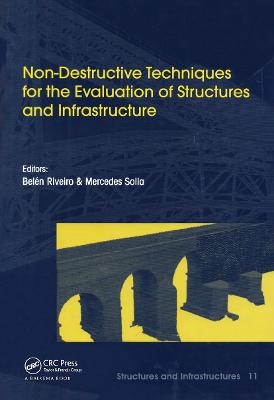
Non-Destructive Techniques for the Evaluation of Structures and Infrastructure
CRC Press (Verlag)
978-1-138-02810-4 (ISBN)
The book is divided into three sections, whose main features are as follows:
Section 1: Fundamentals, principles and applications of: laser scanning, photogrammetry, geophysics, ground penetrating radar, IR thermography, multispectral imaging.
Section 2: Applications to the inspection of infrastructure facilities: tunnels, breakwaters, railways, roads, and modeling of existing buildings (damage inspection in constructions, thermographic 3D modeling, structural modeling of industrial constructions).
Section 3: new management tools and intelligent modeling: infrastructure management systems based on non-destructive technologies for masonry arch bridges, computational approaches for GPR processing and interpretation, automatic processing and object recognition from laser scanning data, BIM for existing buildings.
This cutting-edge edited volume will be a valuable resource for students, researchers and professional engineers with an interest in non-destructive technologies and their applications to reverse engineering of structures and infrastructure.
Dr. Belén Riveiro is an Assistant Professor of Structural Engineering at University of Vigo. She has been an Associate Professor at the School of Civil Engineering and Geosciences of Newcastle University in 2011-12 (UK) and visiting researcher at several research and academic institutions: the Institute for Applied Photogrammetry and Geoinformatics, Oldenburg (Germany, 2009), the Department of Civil Engineering of the New Mexico State University (USA, 2010) and at the Department of Civil Engineering of the University of Minho (Portugal, 2012-2013 and 2014). She got her PhD in the field of Civil Engineering where she tested different geomatic techniques, such as photogrammetry and laser scanning, towards their implementation in structural evaluation processes. Her postdoctoral research focuses on automating LiDAR data processing to implement its products into the field of structural engineering and smart cities. She has published 35 scientific papers in prestigious international journals (JCR) (h-index 8), 28 papers in international conferences, and is co-inventor of 4 patents. During her research career she has been participating as co-investigator in more than 35 national and international projects. Since 2012 she teaches courses of Mechanics of Materials and Stress Analysis, Structural analysis and Construction at the School of Industrial Engineering of the University of Vigo. Dr. Mercedes Solla is an Assistant Professor of Mechanical Engineering, and mainly in Surveying and Construction, at the Defense Centre University (Spanish Naval Academy). Previously to this position, she has taught courses on Surveying and Construction, Non-Destructive Evaluation, Structural Analysis and Construction, and Mechanics of Materials and Stress Analysis at the School of Industrial Engineering at the University of Vigo. She received the PhD degree in the field of Civil Engineering, focusing on the Ground Penetrating Radar (GPR) method. She was a visiting researcher at the School of Engineering, Institute for Infrastructure and Environment at the University of Edinburgh, and she collaborated with the Edinburgh Parallel Computing Centre (EPCC) for the development of advanced FDTD numerical modeling. The purpose was to simulate the propagation of the GPR signal considering more realistic environments that are modeled from data obtained by other complementary geomatic techniques. Her postdoctoral research deals with the development of efficient and automated GPR data processing to structures and infrastructures. Since 2009, she has been collaborating with the Spanish National Research Council (CSIC) and she is an active member of the Transport and Urban Development COST Action TU1208 “Civil Engineering Applications of Ground Penetrating Radar” (Management Committee Member representing Spain and Vice-Chair of Working Group 4 -Different Applications of Ground Penetrating Radar and other Non-Destructive Testing Technologies in Civil Engineering-). She has published 30 scientific papers in prestigious international journals (JCR) (h-index 8), 40 papers in international conferences, and she is co-inventor of 1 patent. Since 2007, she has participated in more than 40 national and international projects.
An Overview of Non-Destructive Techniques. Introduction. Laser Scanning Technology: Fundamentals, Principles and Applications in Infrastructure. Close Range Photogrammetry: Fundamentals, Principles and Applications in Infrastructure. Geophysics. Fundamentals and Applications in Structures and Infrastructure. Ground Penetrating Radar: Fundamentals, Methodologies and Applications in Structures and Infrastructure. Infrared Thermography. Fundamentals, Principles and Applications in Infrastructure. Multispectral Imaging: Fundamentals, Principles and Applications to Damage Assessment in Constructions. Geographic Information Systems: Fundaments and Applications in Infrastructure Management. Applications in Structures and Infrastructure. Non-Destructive Testing of Tunnels: Application of LiDAR and GPR Technologies. Breakwaters Monitoring using Geomatic and Hydrographic Technologies. The Use of Geophysics for the Condition Assessment of Rail Infrastructure. Applications of the GPR Method for Road Inspection. Thermographic 3D Modelling of Existing Constructions. Practical Use of Multispectral Techniques for the Detection of Pathologies in Cultural Heritage Façades. Non-Destructive Techniques Applied to Ancient Masonry Arch Bridges Assessment: Structural Diagnosis and Geometric Modeling. Providing Geometry for the Automatic Creation of Structural Models. Metallic Structures in Industrial Factories. As-Built and Structural. New Management Tools and Intelligent Modelling. Infrastructure Management Systems Based on Non-Destructive Techniques: Roads and Bridges. Advanced Computational Approaches for GPR Processing and Interpretation. New Challenges in Laser Scanning Data Processing: Automatic Processing of Data and Object Recognition. BIM as Management Tool for Existing Buildings.
| Erscheinungsdatum | 29.06.2016 |
|---|---|
| Reihe/Serie | Structures and Infrastructures |
| Verlagsort | London |
| Sprache | englisch |
| Maße | 174 x 246 mm |
| Gewicht | 1043 g |
| Themenwelt | Technik ► Bauwesen |
| Technik ► Maschinenbau | |
| ISBN-10 | 1-138-02810-X / 113802810X |
| ISBN-13 | 978-1-138-02810-4 / 9781138028104 |
| Zustand | Neuware |
| Haben Sie eine Frage zum Produkt? |
aus dem Bereich


